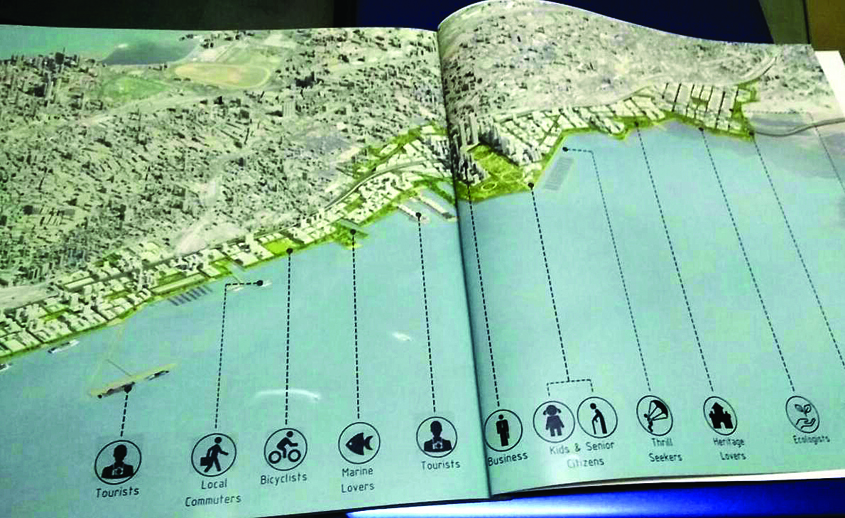The architects who will design this eastern waterfront are the same who have designed Gujarat’s Sabarmati waterfront. HCP Design, Planning and Management Private Ltd, in partnership with PricewaterhouseCoopers and Unity Consultants Pvt Ltd, have won the prestigious bid to develop the entire eastern coastline of Mumbai. In a closely fought competition between top international consortia this week in Mumbai, they emerged as the lowest bidders. “Their technical score was also the highest among all the bidders,” Yashodhan Wanage, Deputy Chairperson, Mumbai Port Trust, told The Sunday Guardian. Next week, the Board meeting of Mumbai Port Trust officials will approve the final bidder on 29 November. Thereafter, the team of architects will be given six months to design the master plan.
Environmentalists have welcomed the move, saying this will help Mumbai develop its highly underutilised water tourism potential. “This is a very welcome move. If the MbPT can demonstrate that the wetland feeding habitat of the birds will not be disturbed and that the livelihoods of the fishing communities will be protected, it is a great move. This area can be turned into a very high quality tourist destination. The city has been wanting for one,” Stalin Dayanand, founder of Vanashakti NGO, said.
Questioned about the environmental impact and effect on livelihoods of traditional fishing communities, Wanage said: “We are committed towards developing an eco-park that will foster and nurture the mudflats for flamingos. We want to turn it into a tourist attraction,” said Sanjay Bhatia, Chairperson, Mumbai Port Trust. Another concern is that of the livelihoods of the fisherfolks at Sweri. “We are going to develop Bhaucha Dhakka better. We are going to extend the present jetty, so more ships can come in. this will be beneficial for the fishing community of Sewri Koliwada. The development will not touch their homes. If anything, it will only improve their livelihoods.”
THE PLAN
The Mumbai Port Trust owns a total of 752 hectares of land on the east coast. Of that, 200 hectares is utilised for the port activities. There are oil tank fields on nearly 200 hectares of land. This leaves the organisation with nearly 350 hectares of land which can be developed. Of this, nearly 165 hectares is currently readily available. This will be utilised in the first phase of development. The first phase will have mixed components of commercial and residential structures. Over 35,000 families residing in slums on encroached MbPT land, and in dilapidated port trust employee quarters will have to be rehabilitated in the same area. The project will have to generate revenue for self-sustenance.
“We want to develop it like some of the best places in the world. For example, the World Trade Centre properties in New York City, Singapore Marina,” said Wanage. Another factor is the proposed Trans-harbour link which will connect peninsular Mumbai to the mainland across the Thane Creek. This will also make the eastern coast the first point of access into the city from the proposed new airport in Navi Mumbai.
“Taking into consideration the city’s needs from its last lung space about marina, sea front walkways, promenades, water sports, plazas, floating restaurants, public transport such as; roads, water, metro, rail, parking places, cycling tracks, entertainment hubs, heritage tourism places, theatres, convention centre, marine museum etc, we decided to commercially exploit the place,” a port trust official said.
THE BIDDERS
Earlier this month, MbPT had shortlisted six internationally renowned bidders to present the concept design before it. These bidders were: 1. 3TI Progetti Italia IngegneriaIntegrata SPA in Consortium with M/s/ Jones Lange LaSalle Property Consultants (India) Pvt Ltd and architect Hafeez Contractor. 2. Perkins Eastman Design Consultants India Pvt Lts, in consortium with STUP Consultants Pvt Ltd and I.L.&F.S. Township and Urban Assets Ltd. 3. Voyants Solution Pvt Ltd in consortium with THR Innovative Tourism Advisors, Spain and KNIGHT FRANK (INDIA) Pvt Ltd. 4. Surbana Jurong Consultant Pte Ltd in consortium with SMEC India Pvt Ltd, Boston Consulting Group. 5. HCP Design, Planning and Management Pvt Ltrd, Ahmedabad, in consortium with PricewaterhouseCoopers Pvt Ltd and Unity Consultants, and 6. Townland Consultants Pvt Ltd, Hong Kong, in consortium with Tata Consulting Engineers Ltd and CBRE South Asia Pvt Ltd.
All of them talked about plans to alter the skyline of the east coast. Some were too lofty without taking into consideration any ground realities, while some talked of innovative land usage.
But barely any developer talked about the issue of flooding. The area is low-lying, with regular flooding woes during monsoon. Barring one, no other developer talked about mangrove restoration too. In fact, one of the developers hinted at flagrant violation of the CRZ regulations. “The challenges are many, like the regulations of MoEF. We will have to work out and see how we can bring buildings closer to the shore,” a bidder who did not win the bid ultimately, said during the presentation. The Ministry of Environmental Affairs has chalked out detailed rules and regulations for any development activities in the coastal zone.
THE WINNING BID
“MbPT—a vision for the Mumbai Port Complex—a socially responsible, economically attractive and implementable concept,” the vision document handed over to MbPT by HCP Design, PWC India and Unity Consultants Pune, stated. Renowned architect Dr Bimal Patel spearheaded the presentation. “It is not just a project offering maximum commercial exploitation, it is an opportunity to address Mumbai’s problems. It is a genuinely implementable concept which is inexpensive and self-financing,” he said in his opening remarks. Their bid price is Rs 8.99 crore. Their focus was mainly on a strong and rigid street network. “Everything else is flexible,” he said.

